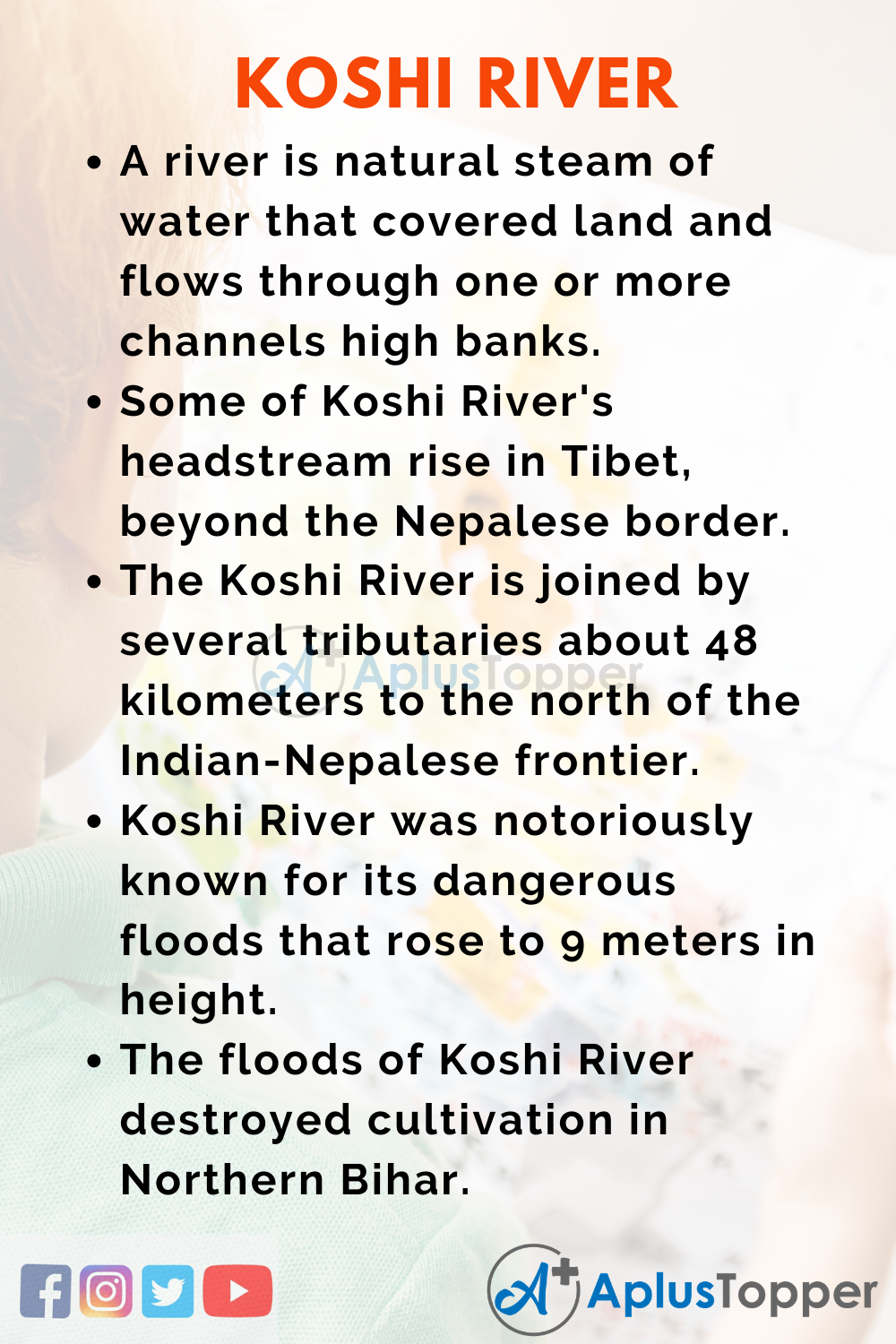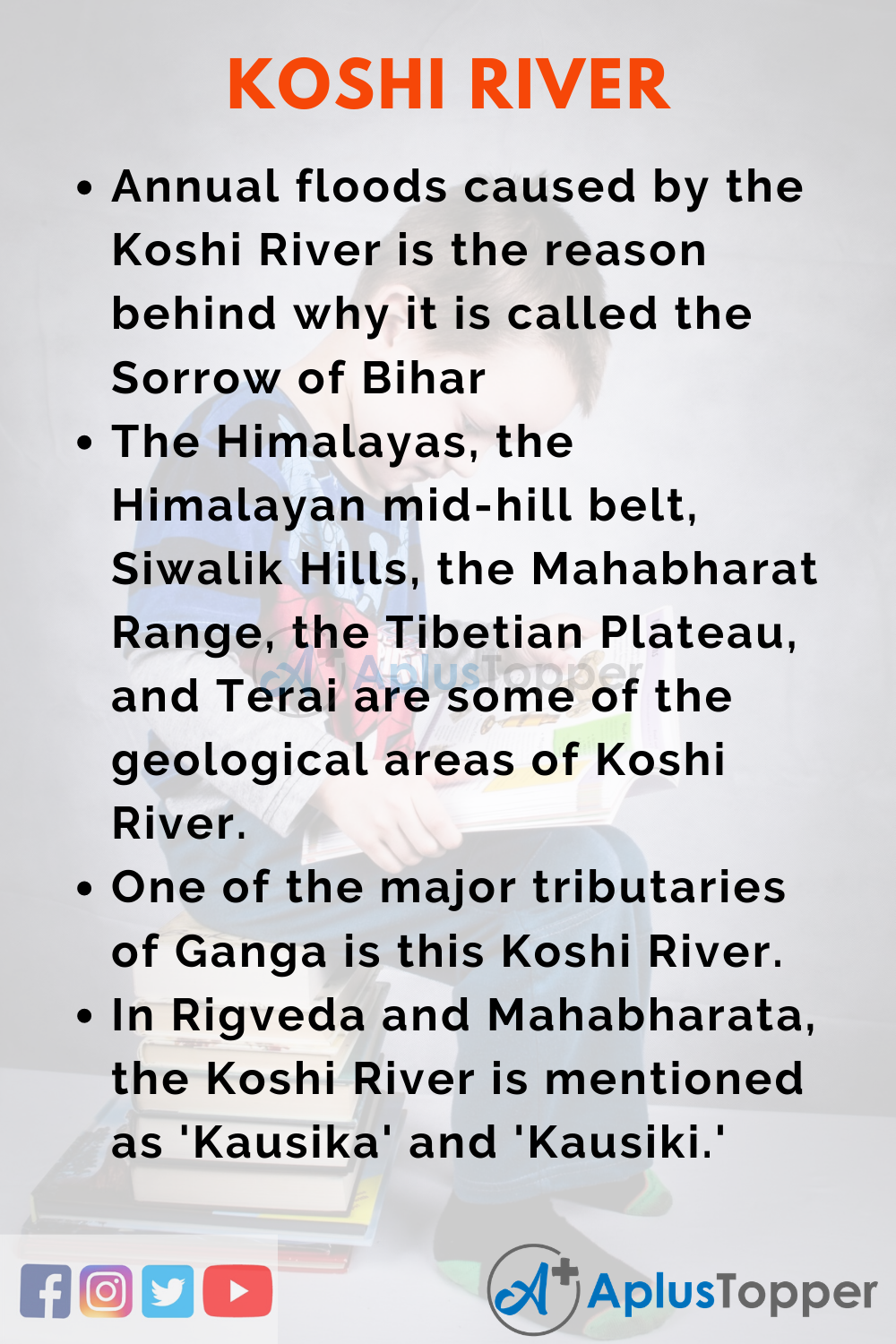10 Lines on Koshi River: A 720-kilometer long river that starts flowing from Tibet and drains in the Ganges of Katihar district is the Koshi River. The Koshi River covers a total area of 74500 square kilometers in China, Nepal, and India. Koshi River flows in both the lands of Nepal and India. The second-largest tributary of Ganga River is Koshi, and the first largest is the Yamuna. The Koshi River is also popularly named Saptakoshi because of its seven upper tributaries. Koshi is a volatile river because of its flood-prone nature during the monsoon season. Koshi River is an essential source for fishery activities, which highly contributes to peoples’ life and the country’s economy.
You can read more 10 Lines about articles, events, people, sports, technology many more.
Set 1 – 10 Lines On Koshi River for Kids
Set 1 is helpful for students of Classes 1, 2, 3, 4 and 5.
- A river is natural steam of water that covered land and flows through one or more channels high banks.
- Some of Koshi River’s headstream rise in Tibet, beyond the Nepalese border.
- The Koshi River is joined by several tributaries about 48 kilometers to the north of the Indian-Nepalese frontier.
- Koshi River was notoriously known for its dangerous floods that rose to 9 meters in height.
- The floods of Koshi River destroyed cultivation in Northern Bihar.
- It was because of those frequent floods that made northern parts of Bihar a struggle for habitation.
- In Bihar, people also used to call the Koshi River as the ‘River of Sorrow.’
- The floods of Koshi River are controlled by the dam built at Barakakshetra, across the Chatra Gorge.
- The dam at Barakakshetra on the Koshi River helps in irrigation, fish hatcheries, and hydropower production.
- The Koshi basin is beneficial for maize/corn cultivation because of the sandy soil.

Set 2 – 10 Lines On Koshi River for School Students
Set 2 is helpful for students of Classes 6, 7 and 8.
- The autonomous region of Tibet, northern slopes of Himalayas, and the southern slopes of Nepal are drained by the Koshi River.
- Among the seven tributaries of Koshi River, the Tamur Koshi originated from eastern Nepal in the Kanchenjungha region.
- The Arun River among the tributaries of Koshi River originated from Tibet.
- The western tributary of the Koshi River named the Sun Koshi had risen from the Gosianthan area.
- The Sun Koshi River also has tributaries, namely the Tamba Koshi, Dudh Koshi, Indravati Koshi, and the Bhote Koshi.
- Some of the Indian tributaries of Koshi River are Bagmati, Kamala, Budhi Gandak, Bhtahi Balan, etc
- After crossing northern Bihar, Saptakoshi divides into the distributary branches.
- The unstable nature of the Koshi River has also contributed to the river’s heavy silt concentration in monsoon.
- Some of the mentionable peaks along the Koshi River’s journey are the Mount Everest, Makalu, Kanchenjunga, Lhotse, Shishapangama, and Cho Oyu.
- One of the largest alluvial fans of the world is the Koshi Rivers alluvial fan covering northeast Bihar.
Set 3 – 10 Lines On Koshi River for Higher Class Students
Set 3 is helpful for students of Classes 9, 10, 11, 12 and Competitive Exams.
- Annual floods caused by the Koshi River is the reason behind why it is called the Sorrow of Bihar
- The Himalayas, the Himalayan mid-hill belt, Siwalik Hills, the Mahabharat Range, the Tibetian Plateau, and Terai are some of the geological areas of Koshi River.
- One of the major tributaries of Ganga is this Koshi River.
- In Rigveda and Mahabharata, the Koshi River is mentioned as ‘Kausika’ and ‘Kausiki.’
- The three major tributaries of the Koshi River meet at Triveni, where the river is called SaptaKoshi.
- One of the oldest trans-boundary rivers of India and Nepal is the Koshi River.
- The origin of the Koshi River is at the height of a 7000-meter altitude above the sea level.
- Koshi River enters the Indian Territory after covering a distance of 50 kilometers.
- Some projects on the Koshi River made to control the flood are Koshi Embankment System, Koshi Barrage, and Sapta-Koshi High Multipurpose Projects.
- The average streamflow of Koshi River 2166 cubic meters per second.

FAQ’s on 10 Lines on Koshi River
Question 1.
What is the Koshi River surrounded by?
Answer:
The Koshi River is surrounded by ridges in the north that separates it from the ‘Yarlung Tsangpo River.’ In the east, the Koshi River is surrounded by Mahananda, and in the west is Gandaki.
Question 2.
Why the Koshi River does not have any permanent channel in the Northern Indian Plain?
Answer:
The course of Koshi River does not have any permanent channels in the Great Northern Indian Plain because of out flushing of debris.
Question 3.
What amount of electricity can be generated by the Koshi Project?
Answer:
The Koshi Project can generate 5.8 lakh kilo-watt of electricity and irrigate around 8.5 lakh hectares of land.
Question 4.
How does the Koshi River influence the lives of other people?
Answer:
Koshi River is one of the major irrigation sources for fields in the northern plains of India; therefore, it is significant for agriculture. Also, the fishery had prospered because of the Koshi River. Koshi River also contributes a generous amount for electricity generation by hydropower.